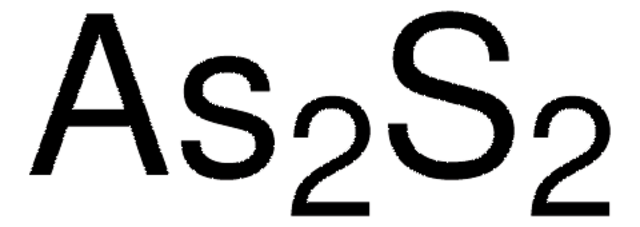202673
Arsenic(III) oxide
99.995% trace metals basis
Sinonimo/i:
ATO, Diarsenic trioxide;, Arsenic trioxide, Arsenous acid
About This Item
Prodotti consigliati
Livello qualitativo
Saggio
99.995% trace metals basis
Forma fisica
powder
Impiego in reazioni chimiche
core: arsenic
reagent type: catalyst
Stringa SMILE
O=[As]O[As]=O
InChI
1S/As2O3/c3-1-5-2-4
IKWTVSLWAPBBKU-UHFFFAOYSA-N
Cerchi prodotti simili? Visita Guida al confronto tra prodotti
Categorie correlate
Descrizione generale
Applicazioni
- Electrochemical detection applications: A study on La-based perovskites incorporated with functionalized carbon nanofibers highlights the use of arsenic trioxide for the electrochemical detection of roxarsone in water and food samples, providing a method to improve safety and environmental monitoring (John Felix MA et al., 2024).
- Antiproliferative effects in cancer research: Research demonstrates the inhibitory effects of arsenic trioxide, combined with metformin, on KG1a cell proliferation, suggesting its potential utility in developing antineoplastic strategies (Huang-Li WH et al., 2024).
- Environmental remediation: A review on manganese oxide-based materials for arsenic removal discusses the application of arsenic trioxide in environmental remediation, focusing on the effectiveness and advancements in arsenic decontamination technologies (Younas M et al., 2024).
Avvertenze
Danger
Indicazioni di pericolo
Classi di pericolo
Acute Tox. 2 Oral - Aquatic Acute 1 - Aquatic Chronic 1 - Carc. 1A - Eye Dam. 1 - Skin Corr. 1B - STOT RE 1
Organi bersaglio
Respiratory system,Cardio-vascular system,Gastrointestinal tract
Codice della classe di stoccaggio
6.1A - Combustible acute toxic Cat. 1 and 2 / very toxic hazardous materials
Classe di pericolosità dell'acqua (WGK)
WGK 3
Punto d’infiammabilità (°F)
Not applicable
Punto d’infiammabilità (°C)
Not applicable
Dispositivi di protezione individuale
Eyeshields, Faceshields, Gloves, type P3 (EN 143) respirator cartridges
Scegli una delle versioni più recenti:
Possiedi già questo prodotto?
I documenti relativi ai prodotti acquistati recentemente sono disponibili nell’Archivio dei documenti.
I clienti hanno visto anche
Il team dei nostri ricercatori vanta grande esperienza in tutte le aree della ricerca quali Life Science, scienza dei materiali, sintesi chimica, cromatografia, discipline analitiche, ecc..
Contatta l'Assistenza Tecnica.










